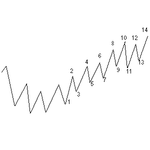JumpOff
1
- Messages
- 702
- Likes
- 14
I've been reading some of the psych/emotional knowledge lab articles. Some of them talk about how unprepared new traders are to deal with the realities of the market - how difficult it is to get mentally prepared for the likely hood of loss. I thought it might be helpful to look at the anatomy of a "let it run" cartoon example, and to look at what is likely to happen, even in the best case scenario. And why traders sometimes have trouble letting even the best of entries "run."
The truth is that the most difficult "emotional management" comes at the beginning of the trade. Feel free to call this part "risk management" if you have no emotions... I've heard a lot of traders talk about how they deal with this - Some set a timer that they can watch count down - to remind themselves that the discomfort is only temporary. Some go fetch the mail, start a load of laundry, watch a video, etc.. Some set in front of their screens and bite their fingernails.. Even if you are working with a tested setup and action plan or are trading with a mechanical system, there is a curiosity about this individual trade - how will it pan out?
I've heard a lot of traders talk about how they deal with this - Some set a timer that they can watch count down - to remind themselves that the discomfort is only temporary. Some go fetch the mail, start a load of laundry, watch a video, etc.. Some set in front of their screens and bite their fingernails.. Even if you are working with a tested setup and action plan or are trading with a mechanical system, there is a curiosity about this individual trade - how will it pan out?
Consider the cartoon below. Long entry made at #1. By point #2 trader is recognising that this trade has potential, commission and spread are covered, and 10 "units" of profit are available if the trade is closed now. But, since it required 8 "units" to enter the trade, the trader knows that long term, that risk:reward ratio wont win out. And the trader knows that all markets pulse back and forth, so prepares for the pullback that will come.
So by point #3 there is only 1"unit" of profit available if the trade is closed now. 90 % of you "profits" are gone. (In slower grinding markets with less slope, sometimes you are back negative at this point!) The first pullback always takes the biggest percentage of your unrealized gains. With each proceeding thrust, the unrealized gain gets larger, and each following pullback (assuming they might be similar in size) becomes a smaller portion of the total. The trade becomes easier to watch.
At some point in a successful trade, a little congestion like we see between 10 and 14 becomes nearly insignificant (something to keep an eye on- but nothing requiring any action, yet that same price action may have taken out the stop of tightly managed entry made at #9.
JO
The truth is that the most difficult "emotional management" comes at the beginning of the trade. Feel free to call this part "risk management" if you have no emotions...
Consider the cartoon below. Long entry made at #1. By point #2 trader is recognising that this trade has potential, commission and spread are covered, and 10 "units" of profit are available if the trade is closed now. But, since it required 8 "units" to enter the trade, the trader knows that long term, that risk:reward ratio wont win out. And the trader knows that all markets pulse back and forth, so prepares for the pullback that will come.
So by point #3 there is only 1"unit" of profit available if the trade is closed now. 90 % of you "profits" are gone. (In slower grinding markets with less slope, sometimes you are back negative at this point!) The first pullback always takes the biggest percentage of your unrealized gains. With each proceeding thrust, the unrealized gain gets larger, and each following pullback (assuming they might be similar in size) becomes a smaller portion of the total. The trade becomes easier to watch.
At some point in a successful trade, a little congestion like we see between 10 and 14 becomes nearly insignificant (something to keep an eye on- but nothing requiring any action, yet that same price action may have taken out the stop of tightly managed entry made at #9.
JO

